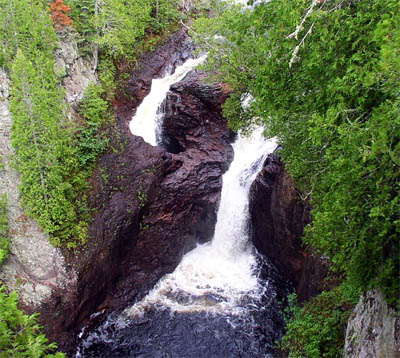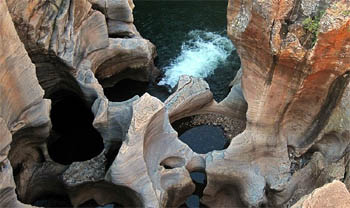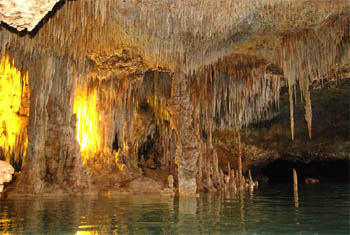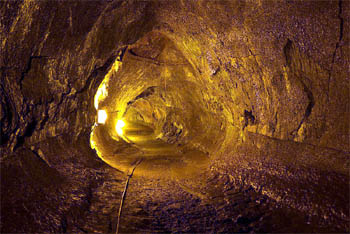pop up description layer
HOME
Cryptozoology UFO Mysteries Aviation Space & Time Dinosaurs Geology Archaeology Exploration 7 Wonders Surprising Science Troubled History Library Laboratory Attic Theater Store Index/Site Map Cyclorama
Search the Site: |
|
The Mystery of the Devil's Kettle
In Minnesota near the border with Canada sits Judge C. R. Magney State Park. Named for a local official who was instrumental in getting state parks and scenic areas established in the region, the park covers over 4,600 acres of forest along the north shore of Lake Superior. Flowing south through the park is the Brule River. The river drops some 800 feet in only eight miles through a series of waterfalls that delight visitors to the park. After rolling over these falls, the river eventually enters Lake Superior. One of these waterfalls, however, is far better known that the others. About a mile and a half upstream from the lake is the mysterious Devil's Kettle Falls. At the top of the falls the river is split into two parts by an outcropping of rhyolite rock. The eastern half of the river flows over an edge, through a two-step waterfall, and down into a pond fifty feet below. The water then continues south along the Brule and out to the lake. The western half of the flow, however, drops ten feet into a "pothole," then vanishes completely. Potholes (or kettles as they are sometimes called) are not in themselves a really strange geological feature. When a stream pours over a waterfall, the force of the water can wear a hole in the rock. As the water swirls around, it can also pick up small pebbles and sand. Over time these can carve out an elliptical, kettle or pot-like hole. Usually the water in a pothole just flows off to one side through a gap, but in the odd case of the Devil's Kettle it disappears underground. Where it goes underground, however, is a total mystery. Scientists who have looked into the enigma are sure the water either eventually rejoins the rest of the river or has its own underwater outlet into Lake Superior. However, every attempt to trace the path of this half of the river has failed. Researchers have put brightly-colored dyes in the water, dropped in ping pong balls and other marked objects, but have never seen any of these emerge anywhere in the area.
Limestone Cave? Making the thing even more puzzling is the geology of the region, which isn't conducive to creating caves or underground rivers. The type of rock under the falls is rhyolite: a hard, igneous, volcanic material very similar to granite. Most caves, however, form in areas with lots of limestone. Limestone is a relatively soft rock which is easily dissolved by water, especially if the water is carrying naturally-occurring carbonic acid. As water seeps underground, it dissolves some of the limestone, creating a path for even more water to follow. While carbonic acid is a very weak acid, over time it can dissolve enough limestone to make a spectacularly large cave. Some caves support underground rivers large enough to carry a small boat. However the nearest limestone to Judge C. R. Magney State Park is hundreds of miles away in southern Minnesota, so an underground river of this sort doesn't seem to be a reasonable solution to the mystery. Lava Tube? Are there other ways to make caves without limestone? Yes, there are. Because much of the rock in the area is volcanic in nature it has been suggested that the solution to the Devil's Kettle mystery might be a lava tube.
A lava tube is a cave formed by lava flowing down from a volcano. Lava is rock, heated until it becomes liquid. When it flows it is possible for the lava on top exposed to air to cool and harden before the lava below does, creating a long, tube-like structure. When the source of the lava ceases flowing, the tube can drain out, leaving an empty space. Some lava tubes can be very large (up to fifty feet in diameter) and long. The most extensive known example is Kazumura Cave in Hawaii which is over forty miles in length. Unlike a limestone cave, which can form thousands or millions of years after the surrounding rock, a lava tube must form at about the same time as the volcanic rock around it. So, the theory is, maybe the water pouring into the pothole was able to drill down into the rock below deep enough to connect up with an old, existing lava tube. The problem is that even though rhyolite is a volcanic rock, it never forms lava tubes. Lava tubes are usually only created in basaltic rock. There is basaltic rock deep below the rhyolite at Magney State Park. The problem is that the basaltic rock down there didn't come from a volcano. It seeped up out of fissures in the ground and spread out over a large, flat area like a flood (in fact this type of rock is known as flood basalt). Because the lava isn't flowing down from a volcano, lava tubes don't form. And even if against all odds one did form, the tube would have to be oriented in just the right direction for the river to take advantage of it, an unlikely coincidence. Fault Line?
So is there another explanation? Sometimes water can flow along a fault line. A fault line is a fracture in the rock caused by the movement of the earth (usually associated with earthquakes). However, there is no indication of a fault line in the area of the waterfall. And even if there was, the amount of water that could flow along it would be relatively small, not half a river. Also, such a passage would have likely been clogged over the years as rocks, sand, logs and other materials fell into the kettle. (There is even a story that somebody pushed an old car into the kettle and it vanished, but this seems unlikely as the location is inaccessible by road). Mystery Solved? In spring of 2017 a scientist from the Minnesota Department of Natural Resources (DNR) announced he thinks he's solved the mystery. Hydrologist Jeff Green beleives he has evidence that somehow the water almost immediately re-enters the river. He and colleagues set up water flow gauging equipment just above and below the falls and found the amount of water going by to be almost identical: 123 cubic feet per second above and several hundred feet below it was almost the same at 121 feet per second. Their conclusion is that the water must re-enter the stream within that distance. In the fall of 2017 the DNR team will try to confirm this by putting dye in the water. One concern, with this technique, however, is that it's been tried before without success. Until Green's test shows positive results, however, what happens to half the Brule River still remains a geologic mystery awaiting some clever person to solve it. The mystery of the lost river (or half a river) is so intriguing, versions of the kettle story have appeared in several books and in fictionalized form in the 2009 movie, Jennifer's Body. If you want to see these mystifying falls you need only to take a trip to Judge C. R. Magney State Park yourself. Observing this puzzling geological feature requires a hike of over a mile and a climb of 200 steps, but it is an adventure well-worth your time. Copyright Lee Krystek 2013-2017. All Rights Reserved. |
|
Related Links |
|
|







